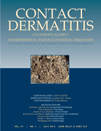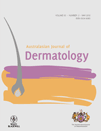
SKIN PHARMACOLOGY AND PHYSIOLOGY
Scope & Guideline
Advancing Insights in Skin Health and Pharmacology
Introduction
Aims and Scopes
- Skin Physiology and Barrier Function:
Research on the structure and function of the skin barrier, including studies on epidermal permeability, hydration, and the effects of various treatments on skin integrity. - Therapeutic Interventions and Clinical Trials:
Clinical studies and trials assessing the efficacy and safety of topical and systemic treatments for skin conditions, including eczema, acne, and psoriasis. - Natural and Synthetic Ingredients:
Exploration of the role of both natural compounds and synthetic agents in skin health, focusing on their mechanisms of action and therapeutic benefits. - Innovative Measurement Techniques:
Development of new methodologies for assessing skin properties and responses, including non-invasive techniques for monitoring skin health and treatment effects. - Microbiome and Skin Health:
Investigations into the relationship between skin microbiota and dermatological conditions, including how treatments affect skin flora and overall skin health.
Trending and Emerging
- Impact of Environmental Factors:
Research examining how environmental stressors, such as pollution and UV radiation, affect skin health and contribute to various dermatological conditions is increasingly prominent. - Psychosocial Aspects of Skin Disease:
Studies exploring the psychological impact of skin diseases, particularly conditions like atopic dermatitis and acne, are gaining attention, highlighting the importance of holistic approaches in treatment. - Novel Therapeutics and Drug Delivery Systems:
Emerging trends include the development of innovative drug delivery systems, such as microneedles and transdermal patches, which enhance the effectiveness of topical treatments. - Natural Ingredients and Alternative Therapies:
There is a growing interest in the therapeutic potential of natural ingredients, with an emphasis on their preventive and therapeutic benefits for skin disorders. - Microbiome Research in Dermatology:
An increasing number of studies are focusing on the skin microbiome's role in health and disease, addressing how treatments can modulate microbiota for improved skin outcomes.
Declining or Waning
- Traditional Cosmetic Studies:
Research focusing solely on cosmetic products without clinical or therapeutic implications seems to be less prevalent, as the journal increasingly emphasizes evidence-based treatments and their physiological effects. - Non-Clinical Animal Studies:
There is a noticeable reduction in purely experimental animal studies, with a shift towards more clinically relevant research that involves human subjects or ex vivo skin models. - Basic Biochemical Pathway Studies:
Investigations into fundamental biochemical pathways without direct clinical application or therapeutic context are declining, as the focus shifts towards translational research that bridges basic science and clinical practice.
Similar Journals

Dermatology Practical & Conceptual
Exploring innovative solutions in skin health and research.Dermatology Practical & Conceptual is a prominent open-access journal dedicated to advancing the field of dermatology through the dissemination of cutting-edge research and practical insights. Published by MATTIOLI 1885, this peer-reviewed journal has been committed to open access since 2015, ensuring that valuable information is readily available to researchers, healthcare professionals, and students worldwide. With a focus on innovative and practical approaches in dermatology, as well as its intersections with genetics, molecular biology, and oncology, the journal has established a strong academic presence, achieving a Q2 ranking in Dermatology and notable positions in related fields for 2023. Although its Scopus rankings indicate room for improvement in certain areas, such as genetics and molecular biology, the journal's commitment to quality and accessibility is evident in its engagement with contemporary research trends. The editors invite submissions that address practical challenges and novel methodologies, fostering a multidisciplinary dialogue that enhances dermatological practice and research. The journal operates from its base in Fidenza, Italy, and as it looks toward converged years from 2019 to 2024, it aims to further strengthen its influence and contribute significantly to the dermatological landscape.

JOURNAL OF DERMATOLOGICAL TREATMENT
Opening doors to groundbreaking dermatological discoveries.The JOURNAL OF DERMATOLOGICAL TREATMENT, published by TAYLOR & FRANCIS LTD, is a premier forum dedicated to advancing the field of dermatology through the dissemination of high-quality research. Since its inception in 1989, this journal has maintained a significant impact on the dermatological community, currently ranking in the top quartile (Q1) of the Dermatology category with an impressive Scopus ranking of #14 out of 142 journals, reflecting its reputation among peers and its contribution to the clinical and academic landscape. The journal shifted to Open Access in 2023, enhancing the accessibility of groundbreaking findings to researchers, clinicians, and students worldwide. With a commitment to publishing diverse articles, from innovative treatment modalities to comprehensive reviews, the JOURNAL OF DERMATOLOGICAL TREATMENT serves as an invaluable resource for professionals seeking to stay at the forefront of dermatological science in a rapidly evolving field.

CONTACT DERMATITIS
Enhancing Treatment Strategies for Skin ConditionsCONTACT DERMATITIS, published by WILEY, is a leading international journal focused on the vital field of dermatology, particularly examining the diagnosis, treatment, and management of contact dermatitis and related skin conditions. With origins dating back to 1975 and a planned convergence period extending to 2024, this esteemed journal serves as a crucial resource for researchers, clinicians, and healthcare professionals dedicated to advancing knowledge in dermatological practices. In the latest rankings, it has achieved a commendable Q2 classification in Dermatology and Q3 classification in Immunology and Allergy for 2023, underscoring its significance within these dynamic fields. Moreover, it holds a notable ranking of #29/142 in Medicine & Dermatology and #130/233 in Medicine & Immunology and Allergy according to Scopus metrics, placing it in the top tier of scholarly publications. While the journal operates on a subscription basis, its comprehensive reviews, original articles, and insightful research findings are invaluable for pushing the boundaries of current dermatological and immunological knowledge. By fostering a deeper understanding of the complexities of skin reactions and their implications, CONTACT DERMATITIS plays a vital role in connecting research with clinical practice, making it an essential read for anyone engaged in the field.

Turkderm-Turkish Archives of Dermatology and Venerology
Connecting Professionals Through Open Access ResearchTurkderm - Turkish Archives of Dermatology and Venerology, published by GALENOS PUBL HOUSE, serves as a vital platform for the dissemination of innovative research and advancements in the fields of dermatology and venerology. With an Open Access policy implemented since 2002, this journal aims to provide free and unrestricted access to significant findings, ensuring that vital information reaches a global audience. Based in Turkey, the journal has positioned itself as an important resource for professionals, researchers, and students alike, despite currently being categorized in Q4 of both Dermatology and Infectious Diseases as per the 2023 metrics. Although it faces competition in the rankings, with a Scopus standing of #131 in Dermatology and #331 in Infectious Diseases, its dedication to advancing knowledge in these critical health areas is unwavering. The journal continually invites original research, reviews, and case studies that enhance clinical practices and foster understanding in the dermatological community.

AUSTRALASIAN JOURNAL OF DERMATOLOGY
Empowering professionals with cutting-edge dermatological research.Australasian Journal of Dermatology is a leading publication in the field of dermatology, issued by Wiley since 1951, and reaching an audience of researchers, clinicians, and students interested in the latest advancements and practices in skin health. With an ISSN of 0004-8380 and an E-ISSN of 1440-0960, this journal stands out with its Q2 ranking in both Dermatology and Miscellaneous Medicine, positioning it within the top 61st percentile of its category according to Scopus. Although it does not provide Open Access options, Australasian Journal of Dermatology is committed to disseminating high-quality research that informs clinical practices and promotes scholarly dialogue. By publishing rigorous and peer-reviewed articles focused on various aspects of dermatological science, the journal plays a pivotal role in enhancing the dermatology community's understanding of skin conditions and treatments, making it an invaluable resource for professionals and students alike.

Dermatologie in Beruf und Umwelt
Fostering Best Practices in Occupational DermatologyDermatologie in Beruf und Umwelt is a reputable journal published by DUSTRI-VERLAG DR KARL FEISTLE, focusing on the intersection of dermatology, occupational health, and environmental influences on skin health. With its ISSN 1438-776X and E-ISSN 1616-7090, this journal serves as a crucial platform for disseminating research findings and clinical practices that address the dermatological concerns arising in diverse occupational settings. Although the journal's coverage in Scopus concluded in 2021, it remains significant within the medical community, evidenced by its rankings within the 29th percentile in Medicine - Dermatology and 20th percentile in Medicine - Public Health, Environmental and Occupational Health. While it follows a traditional access model, its commitment to enhancing knowledge and promoting best practices in skin health makes it an essential resource for researchers, clinicians, and public health professionals eager to explore the complex relationship between work environments and dermatological outcomes.

JOURNAL OF INVESTIGATIVE DERMATOLOGY
Bridging Biochemistry and Dermatology for a Healthier FutureJOURNAL OF INVESTIGATIVE DERMATOLOGY, published by Elsevier Science Inc, stands at the forefront of research in the fields of dermatology, biochemistry, cell biology, and molecular biology. With an impressive impact factor reflecting its Q1 ranking in Dermatology and Biochemistry, this journal provides a vital platform for disseminating groundbreaking research and innovative studies that drive forward our understanding of skin biology and disease. The journal has maintained a distinguished presence since its inception in 1945, successfully converging decades of scientific inquiry and expertise. It ranks among the top journals in medicine and dermatology, holding a remarkable 7th place out of 142 in the Scopus Medicine Dermatology category, signaling its influence and relevance in the academic community. Researchers, professionals, and students alike will find valuable insights into cutting-edge investigations and methodologies to advance their own studies in skin health and pathology. While the journal is not an open access publication, access options remain robust for institutions and individuals committed to the advancement of dermatological science.

Annals of Dermatology
Elevating dermatology with impactful research.Annals of Dermatology is a prestigious academic journal published by the Korean Dermatological Association, focusing on the latest research and advancements in the field of dermatology. With a commitment to advancing knowledge in skin health and disease, this journal serves as a vital resource for researchers, clinicians, and students working in dermatology and related disciplines. Since its inception in 1989, it has evolved to consolidate its position in the academic community, boasting a Q2 ranking in the 2023 Dermatology category and a Scopus rank of #87 out of 142, placing it in the 39th percentile. Although it operates under a subscription model, the journal's impact factor reflects its significance in advancing dermatological research, attracting innovative studies and reviews that shape clinical practice. With a publication history extending from 1989 to 1996 and then from 2008 to the present, Annals of Dermatology continues to be an essential publication for those devoted to improving skin health.

Postepy Dermatologii i Alergologii
Championing open access to vital health insights.Postepy Dermatologii i Alergologii is a distinguished Open Access journal published by TERMEDIA PUBLISHING HOUSE LTD, dedicated to advancing the fields of Dermatology and Immunology and Allergy. Since its inception in 2003, this journal has served as a vital platform for researchers and practitioners alike, promoting knowledge sharing and collaboration in Poland and beyond. With a current impact ranking placing it in the Q3 quartile for both Dermatology and Immunology and Allergy categories, it plays a significant role in contributing to academic discourse within these fields. The journal is indexed in Scopus, with respectable rankings reflecting its relevance and quality—#65/142 in Dermatology and #163/233 in Immunology and Allergy. Researchers are encouraged to explore a vast array of innovative studies and reviews, making it an essential resource for anyone seeking to stay at the forefront of dermatological and allergic research. For those interested in discovering groundbreaking findings and contributing to the ongoing dialogue in these disciplines, Postepy Dermatologii i Alergologii offers not only free accessibility but also a commitment to scholarly excellence.

Journal of Drugs in Dermatology
Unveiling the latest breakthroughs in skin treatment.Journal of Drugs in Dermatology, an esteemed publication in the field of dermatology, serves as a vital resource for researchers, clinicians, and healthcare professionals dedicated to advancing knowledge and practices in skin-related therapies and treatments. Established in 2002 and published in the United States, this journal focuses on a wide range of topics pertinent to dermatological pharmacology and therapeutics, reflecting contemporary scientific advancements and innovative approaches to patient care. With a strong presence in Scopus rankings, situating it at rank #73 within the dermatology category, and achieving a commendable Q2 quartile classification in both dermatology and general medicine categories, the journal is committed to enhancing understanding of drug efficacy and safety in dermatological conditions. While the journal maintains a traditional access model, its impact factor underscores its significance in the research community, supporting the ongoing dialogue between academia and clinical practice. We invite professionals and students alike to explore the latest findings and contribute to the progressive discourse on dermatological treatments through this important publication.